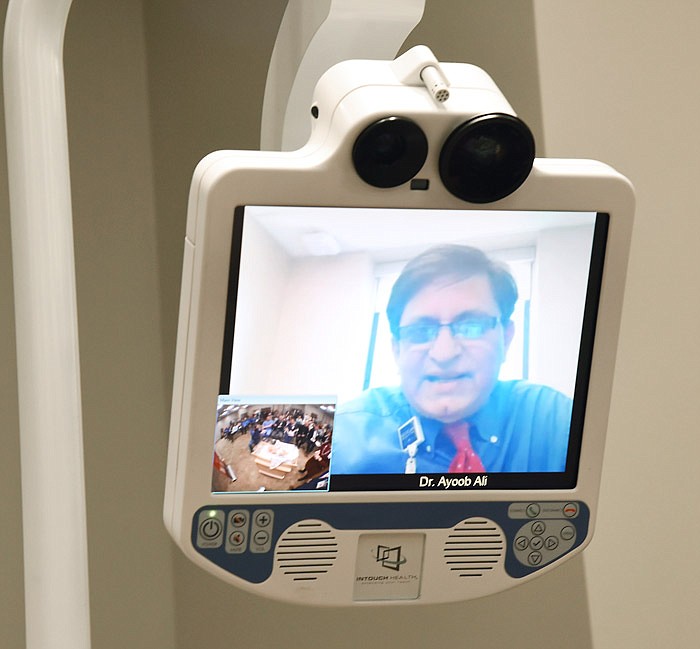After a slow start, local efforts to improve Missouri's Medicaid system by letting health care providers incorporate new communications technology to deliver services have begun to take stride.
Early this year, St. Mary's Hospital in Jefferson City began a new technological partnership with SSM Cardinal Glennon Children's Hospital, SSM Health DePaul Hospital in St. Louis and SSM Health St. Clare Hospital in Fenton. Through the partnership, telemedicine allows each of the out-of-town hospitals to share their specialists' expertise with St. Mary's emergency department, birthing center and pediatrics clinic.
State legislation - sponsored by state Rep. Jay Barnes, R-Jefferson City - that allows the state to reimburse health care providers for services it provides to Medicaid patients through telemedicine was signed into law in June.
It was a bill Barnes first proposed in 2016, but at that time, the Legislature put "unreasonable restrictions on telehealth services," he said in a Feb. 4 column in the News Tribune. Restrictions would have required a "facilitator" in all interactions between patients and physicians, he said. And it would have prohibited the use of telehealth technology if the patient lived fewer than 24 miles from the provider's location.
House Bill 1617 overcomes those hurdles.
Areas in Missouri continue to struggle with health coverage shortages, said Dave Dillon, vice president of public and media relations with the Missouri Hospital Association.
"Ultimately, the real winner is the individual patient on the other side of the screen," Dillon said. "This change will allow some degree of transformation of how some Medicaid enrollees receive treatment."
Many people below the federal poverty line, who are on Medicaid, have transportation problems and can't travel to see specialists, for example.
Those patients are people community health centers are intended to serve.
Jeff Davis, director of Community Health Center of Central Missouri, said his organization has used teleconferencing - mostly for mental health services - for about a year. The Jefferson City clinic receives some psychiatry services through telehealth.
"We're still looking at how the legislation is going to work with what we're going to be doing," Davis said. "In theory, it should help us."
The health center also uses telehealth to provide services between its clinics, he said. If it has a need in Linn, Fulton or California, it can meet the need.
Sometimes telehealth is the only way to provide the "psychiatric time" for a patient in a rural clinic. The technology allows the clinics to meet a "sporadic" demand. It can prevent the clinics from having to send somebody home and asking them to return when a provider is available.
"If I can pop them right in and have them right away talk to a telehealth provider, we find that's much more effective," Davis said.
Capital Region Medical Center uses telehealth to provide counseling for corporate clients of its Employee Assistance Program, said Lindsay Huhman, director of marketing and public relations for the Jefferson City hospital. Staffed by licensed mental health professionals, it is a free, voluntary, and confidential counseling and referral service designed to help people with personal, family or job-related problems.
Counseling visits can be done virtually.
The hospital continues to develop a process for other specialties including therapy services and specialty providers, Huhman said. It also is working on ways to implement telehealth within rural health clinics.
It's not new, that in rural parts of the state, there aren't enough doctors, Dillon said.
There also is a shortfall of nurse practitioners and physicians assistants, which the Missouri Hospital Association sees as service extenders, to fill that demand, Dillon said.
There's a big push to use the technology to provide more and more services, Davis said. And while increasing numbers of health care providers are using telehealth technologies, some patients have been slower adapting to it. But, he added, they're coming around.
Once patients get used to it, they'll begin to see it more often.
St. Mary's Hospital uses telehealth to improve the speed in which it provides some services. Adult patients experiencing stroke symptoms can receive specialty care in the emergency department through a telemedicine partnership with SSM Health DePaul Hospital in St. Louis or SSM Health St. Clare Hospital in Fenton, said Patrick Wood, communication and marketing consultant for SSM Health.
Neurologists from the partner hospitals can assess patients who may be able to recover close to home rather than being transferred to another facility.
"Telehealth offers our community the opportunity to expand the services that are provided here," Wood said, "and allows for patients to receive specialty care close to home."

